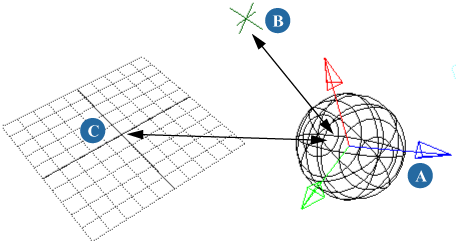The location of an object in 3D space is defined by a point called its center. This location can be described in more than one way or according to more than one frame of reference. For example, the global position is expressed in relation to the scene's origin. The local position is expressed in terms of the center of the object's parent.

The location of an object and its center (A) is expressed differently in relation to its parent (B) than in relation to the scene origin (C).
The center of an object is only a reference — it is not necessarily in the middle of the object because it can be relocated (as well as rotated and scaled). The position, orientation, and scaling (collectively known as the pose) of the object's center defines the frame of reference for the local poses of its own children.
Throughout Softimage, lengths are measured in Softimage units. How big is a Softimage unit? It is an arbitrary, relative value that can be anything you want: a foot, 10 cm, or anything else.
However, it is generally recommended that you avoid making your objects too big, too small, or too far from the scene origin. This is because rounding errors can accumulate in mathematical calculations, resulting in imprecisions or even jittering in object positions. As a general rule of thumb, an entire character should not fit within 1 or 2 units, nor exceed 1000 units.
The Softimage units used for objects also matters for creating dynamic simulations where objects have mass or density and are affected by forces such as gravity. For more information, see Size Does Matter [ Simulation and Effects].
 Except where otherwise noted, this work is licensed under a Creative Commons Attribution-NonCommercial-ShareAlike 3.0 Unported License
Except where otherwise noted, this work is licensed under a Creative Commons Attribution-NonCommercial-ShareAlike 3.0 Unported License